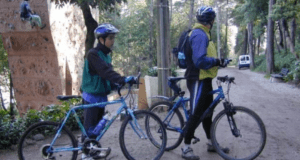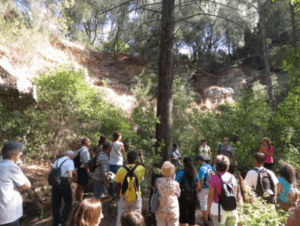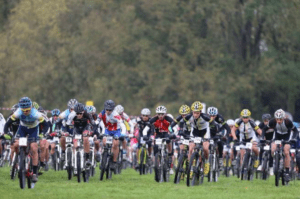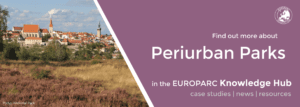Green exercise & outdoor sports in Periurban Parks: challenges & solutions
Source: Damien Prost-Romand presentation
During the Conference 2019 in Latvia, EUROPARC held a number of workshops to discuss diverse topics relevant to Protected Area management. In case you have not attended, or want to read about their outcomes, we summarised the content of some of these workshops in a series of online articles.
“Spending time in nature and practicing outdoor sports is good for our health”
said Dr William Bird, one of the keynote speakers EUROPARC Conference 2019, and author of “Nature and Public Health: the role of nature in improving the health of a population“.

Source: Fernando Louro Alves presentation
Periurban Parks around cities offer natural landscapes where many urban dwellers come to spend time outdoors. In the past years, Periurban Parks have registered a huge increase of visitors numbers – both individuals and participants in collective sports events.
That is all good…until this increase becomes massive and starts creating problems among the users, and damage to species and their habitats.
In the last years, Periurban Parks have registered a huge increase of visitors numbers.
In order to discuss this issue, which represents one of the main current challenges for Periurban Parks, the Periurban Commission held the Workshop #5.2: How do we manage green exercise and the increase of outdoor sports in Periurban Parks?
The discussion focused on two main aspects:
- What can be done in terms of planning to better manage the increase of public use?
- What protocol can a park apply to minimise damages when organising a mass sports event?
Making green exercise compatible with biodiversity: a case study from Portugal
Download the presentation: Trails and zoning in Parque Florestal de Monsanto (Lisbon) devised to make green exercise and biodiversity as much compatible as possible
Presented by Fernando Louro Alves
In order to deal with the management of public use, Fernando insisted on the need to step back and carefully plan the park, giving special attention to mobility – especially slow mobility – and accessibility.

Source: Fernando Louro Alves presentation
The Monsanto Forest Park has been divided into several zones, based on different uses. For instance, the use of bikes is only allowed in one zone. However, bikers don’t always respect this regulation. At points of conflict, the Park has used conciliation participatory techniques to sort them out.
Trails, where the park wants to attract more visitors to, are clearly designed as such – they have permeable pavement, very good drainage systems and are made of native materials. These trails are beautifully designed and ranging different difficulty options.
Download the map of Parque Florestal de Monsanto
We need to step back, plan carefully and pay special attention to mobility and accessibility.
On the other hand, the park installed obstacles in trails where they intend to lower visitor numbers. Other measures, like promoting good network of public transport, reducing parking lots, implementing slow mobility etc., aim to reduce the traffic in the park’s surroundings.
The discussion in the first part of the workshop gave rise to several points:
- Bad use of parks with people not knowing it => Unconsciousness of visitors of their real impact
- The emergence of new modalities of outdoor adrenaline-like sports (down-hill descent) and engines (new type of bikes, electric bikes, scooters, etc.) => Staff is not prepared to deal with so many new activities in such short periods of time.
Limiting the negative impacts of sports events hosted by parks: a case study from France
Download the presentation: What interest does a park have in organizing or hosting sports events and what are the rules to be adopted to limit their negative impacts?
Presented by Damien Prost-Romand from the Grand Parc Miribel – Jonage in Lyon

Source: Damien Prost-Romand presentation
For the Grand Parc Miribel-Jonage, the starting point is that collective sport events are good to promote physical health but also social cohesion; they bring economic benefits and create and reinforce the park’s identity. However, collective sport events might also create damage to habitats and sensitive species.
This is why the Grand Parc Miribel-Jonage, which is a Natura 2000 site, has established a protocol to regulate how mass events need to be organised and approved by the management entity.
Collective sports events promote physical health and social cohesion, but might also case damage to habitats and sensitive species.
During the discussion, many agreed on the general lack of political will and back-up of parks. Particularly, decision-makers usually:
- Do not respect the Parks’ carrying capacity limits. They always push to host the biggest run ever, biggest contest ever, etc. without paying attention to the consequences for the park.
- Do not provide enough resources for law enforcement.
Read the case study on hosting a mass event in a Natura 2000 site, the Grand Parc Miribel-Jonage.
Many of the challenges that Periurban Parks are facing, stem from the lack of understanding of the important role these spaces play for the good quality of life in cities. Acknowledging this fact, the Periurban Commission launched the position paper Periurban Parks, their place in EU policies at the EUROPARC Conference 2019.
Besides that, the commission is working on a Toolkit on Public Use Design & Management in Periurban Parks. The aim is to give practical advice on design and management measures to host different kinds of visitors, avoid conflicts among them and reduce impact on biodiversity.
If you have a case study or good practice that you would like to share with us, please submit them here. We will be happy to promote your success and inspire others!
